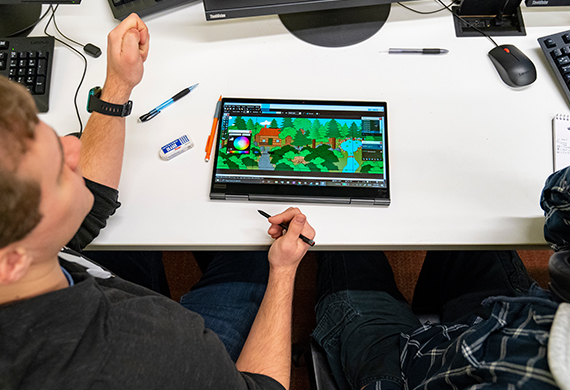Game design is the art and science of creating interactive experiences that entertain, engage, and challenge players. It is a multidisciplinary field that combines elements of storytelling, visual design, psychology, and technology to bring virtual worlds to life. In an introductory course on game design, you will delve into the fundamental principles and concepts that form the building blocks of game creation.
At its core, game design revolves around the concept of gameplay, which encompasses the rules, mechanics, and interactions that define how players engage with a game. Understanding the psychology behind player motivation and engagement is crucial in crafting compelling gameplay experiences. You will learn how to create captivating challenges, balance difficulty levels, and provide satisfying rewards to keep players immersed and motivated.
In addition to gameplay, storytelling plays a vital role in game design. Through narrative design, you have the power to create rich, immersive worlds and captivating characters that draw players into the game’s universe. You will explore techniques for creating engaging narratives, developing memorable characters, and constructing cohesive story arcs that drive the player’s journey.
To bring your game ideas to life, you will gain hands-on experience with various game design tools and technologies. You will be introduced to popular game engines and software used in the industry, allowing you to prototype and develop your own games. Through practical exercises, you will learn to create game assets, integrate audio and visual elements, and design user interfaces that enhance the player experience.
The field of game design is dynamic and ever-evolving, with diverse genres and platforms to explore. From casual mobile games to immersive virtual reality experiences, you will gain an understanding of different game genres and their unique characteristics. This knowledge will enable you to tailor your design choices to suit specific target audiences and create engaging experiences across various platforms.
By the end of the course, you will have a solid foundation in game design principles and the skills necessary to create your own games. Whether you aspire to become an independent game developer, work in a game studio, or simply want to expand your creative horizons, the introduction to game design course is your gateway into the exciting world of game creation. Get ready to unleash your imagination and embark on a journey to become a skilled game designer.
Game Design Tools and Technologies

In the world of game design, having a strong grasp of the tools and technologies available is essential for bringing your creative visions to life. In a course focused on game design tools and technologies, you will gain practical knowledge of the software and resources used by professionals in the industry.
One of the key components you will explore is game engines, which serve as the foundation for game development. You will learn about popular game engines such as Unity and Unreal Engine, understanding their features, capabilities, and workflow. Through hands-on exercises, you will gain proficiency in using these engines to build interactive and immersive gameplay experiences.
In addition to game engines, you will also dive into other essential tools used in game design, such as software for creating game assets, level editors, and animation tools. These tools allow you to design and implement characters, environments, and objects within your games. You will learn techniques for creating 2D and 3D assets, integrating animations, and optimizing assets for performance.
Furthermore, you will explore audio and visual elements and their integration into games. You will discover resources for acquiring or creating sound effects and music, and how to integrate them seamlessly into your game projects. Understanding the principles of visual design, including color theory, composition, and typography, will also be covered, empowering you to create visually appealing and cohesive game aesthetics.
Throughout the course, you will have the opportunity to experiment with different tools and technologies, honing your skills and discovering the ones that best suit your creative style and project goals. By the end, you will have a solid understanding of the tools and technologies used in the game design industry, equipping you with the necessary knowledge to embark on your own game development projects with confidence.
User Experience and Interface Design

User experience (UX) and interface design are integral aspects of game design that directly impact how players interact with and perceive a game. In a course dedicated to user experience and interface design, you will learn the principles and techniques for creating engaging and intuitive gaming experiences.
UX design focuses on understanding the needs, expectations, and preferences of players. By employing user-centered design methodologies, you will explore ways to enhance player immersion and enjoyment. This involves conducting user research, creating user personas, and designing gameplay mechanics and features that cater to the target audience.
Interface design involves crafting intuitive and visually appealing user interfaces (UI) that facilitate seamless interaction between players and the game. You will learn about UI design principles, including layout, navigation, and visual hierarchy, to create interfaces that are easy to navigate and aesthetically pleasing. Through prototyping and iteration, you will refine and optimize your designs to ensure a smooth user experience.
In addition to designing the user interface, you will delve into the importance of feedback systems and player engagement. You will explore techniques for providing meaningful feedback to players, such as visual and auditory cues, to enhance their understanding of the game world and their actions. Additionally, you will learn about techniques for fostering player engagement through compelling progression systems, rewards, and challenges.
To validate and improve your designs, you will delve into playtesting and gathering user feedback. By conducting playtests with real players, you will gain valuable insights into the usability and effectiveness of your game’s user experience and interface. This feedback will inform iterative design improvements, ensuring that your game resonates with its intended audience.
By mastering the principles and techniques of user experience and interface design, you will be equipped to create games that are not only visually appealing but also intuitive and immersive. Whether you aspire to design mobile games, console games, or virtual reality experiences, a solid understanding of UX and interface design is vital for crafting memorable and engaging gaming experiences.
Studying as a Game Designer

In the game designer course, a crucial aspect you will explore is user experience and interface design. Understanding the needs and preferences of players is essential in creating immersive and enjoyable gaming experiences. You will learn the principles of UX design, conducting user research, and creating user personas to inform your game design decisions. Additionally, you will delve into interface design, crafting intuitive and visually appealing user interfaces that enhance player engagement. Through playtesting and feedback gathering, you will refine your designs to ensure a seamless and captivating user experience.
 Imagup General Magazine 2024
Imagup General Magazine 2024



